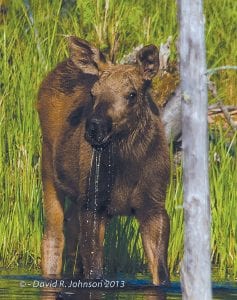A moose calf morbidity study begun in May by the Department of Natural Resources indicates only 15 of the 49 radio-collared calves are left to track. It is believed eight calves were abandoned by their mothers, one drowned, four were killed by bears, eight were killed by wolves, and three more were probably killed by wolves. Four slipped their collars and may be okay, like this little guy.

The moose calf morbidity study begun in May 2013 with 49 calves captured and collared with GPS homing devices by Minnesota Department of Natural Resources (DNR) workers now shows there are only 15 calves left to track.
But the high rate of mortality has slowed down, said Glenn DelGiudice, Ph.D., the research scientist in charge of the study.
“The last calf mortality was July 2, a bear-kill. Calf mortality has slowed down quite a bit since the last two weeks of June,” said DelGiudice.
As of July 21, the preliminary causes of natural mortality included: two cases of natural abandonment; one abandonment of unknown cause; one drowning; four bear kills; eight wolf kills; and three probable wolf-kills.
Early results indicated eight calves were abandoned by their mothers shortly after the capture/collar effort. At that time DelGiudice said, “We don’t know why. They might have been young mothers, cows in poor physical condition, maybe they couldn’t nurse or were ill or maybe they were affected by the collar/capture effort.”
Four calves have slipped their collars and may be okay.
A normal calf mortality rate is 60 percent, but scientists have noted that in recent years calf mortality has grown to 70 to 80 percent in Minnesota, not enough to sustain the moose herd. Seemingly healthy adults are also dropping dead, and researchers are in a mad race to figure out what is causing moose to die at such an alarming rate.
In northern Minnesota moose have declined from more than 8,600 in 2006 to less than 3,000 last year. In northwestern Minnesota there are fewer than 20 moose left from a herd of over 4,000 in the mid-80s.
This calf morbidity study dovetails with a larger ongoing study of GPS-collared adult moose and is also related to several insect studies which should help scientists put the pieces of the puzzle together so they can form a picture of what is causing the moose to disappear.
Helping the DNR in this wide-ranging hunt for evidence is the 1854 Treaty Authority, Fond du Lac, and Grand Portage Band of Lake Superior Chippewa, the U.S. Forest Service and the University of Minnesota College of Veterinary Medicine.


Loading Comments